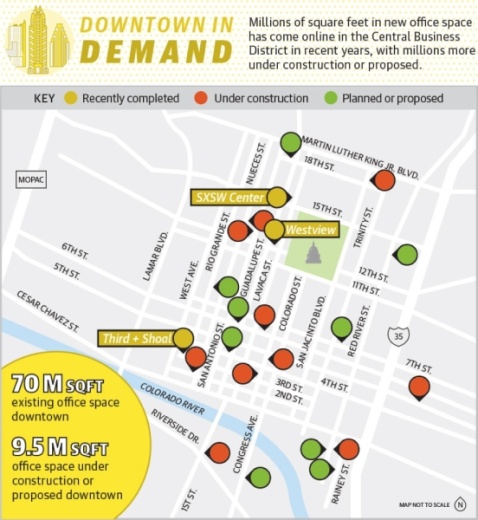Since 2007, office rents have increased more than 80% in Austin’s CBD, more than any office market in the country outside of the San Francisco Bay Area, said Sam Tenenbaum, director of analytics for commercial real estate information company CoStar.
Office rents in the CBD are approaching $50 per square foot, according to a CoStar market analysis that Community Impact Newspaper received from Gayle Berkbigler, senior vice president at the commercial real estate firm St. Croix Capital.
This is about $10 more than any other office market in Central Austin, per the analysis, and increases to up to $75 a square foot when the costs of a triple net lease—in which a tenant pays all property expenses, including taxes, insurance and maintenance—are considered.
Yet demand is strong; CoStar reports a 5.6% vacancy rate.
In addition to the 70 million square feet of existing development in downtown Austin, an additional 9.5 million square feet is under construction or has been proposed, according to the Downtown Austin Alliance’s April report, State of Downtown.
The CBD is desirable because of its amenities, said Charisse Bodisch, senior vice president of economic development for the Austin Chamber of Commerce.
“These developments where people can go walk to lunch or can ride a bike to lunch ... that’s why downtown’s popular,” Bodisch said.
In 2019, unemployment for technology occupations in the U.S. fell to a 20-year low of 1.3%, compared to 3.6% for all industries nationally and 2.7% in Austin, per the U.S. Bureau of Labor Statistics. As a result, tech companies rely on luxury offices and amenities to attract employees.
“The biggest cost to companies isn’t their lease,” Tenenbaum said. “It’s their people.”
Demand for office space in the CBD may also help other markets around town, per the CoStar analysis.
In December, ground broke on a 795,000-square-foot office building in the Mueller Business District.
Like the CBD, Mueller’s business district offers walkability and amenities, Aquila Principal Ben Tolson said.
“You go out to Mueller and it’s a very clean, green environment. Downtown, there’s congestion, a homelessness issue,” he said. “It’s being confronted by its own success.”




